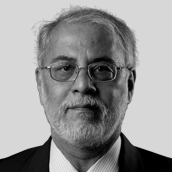
Dr. Manoj Joshi is a Distinguished Fellow at the Observer Research Foundation, India's leading think tank. He is a journalist, author, commentator, and columnist.
The South Asian diaspora provides not only cutting-edge, top managerial talent around the world but also a vast army of skilled and semi-skilled workers and service personnel who keep entire societies in the Persian Gulf running. The western Indian province of Gujarat, renowned for its business skills and entrepreneurial talent, has one of the most active diasporas in the world, spread out mainly in East Africa, the UK, and the USA.
Sometime in the night of 19 January, a family of four, including an infant, were separated from a larger group of people illegally crossing the border from Canada to America in the midst of a blizzard. The next morning, the Royal Canadian Mounted Police found them a little short of the border, frozen to death. It turned out that they were a family from Gujarat, hoping to make a better life in the USA.

Coincidentally, and at the other end of the scale, less than a week after this tragedy, two Indian American CEOs — Sundar Pichai of Google and Satya Nadella of Microsoft — figured in an annual Indian government list as recipients of a high national award. Both were born and educated in India and are leaders of a global pack of CEOs that includes Shantanu Narayen of Adobe, Leena Nair of Chanel, Arvind Krishna of IBM, Sanjay Mehrotra of Micron, Nikesh Arora of Palo Alto Networks, and Parag Agarwal of Twitter.
There are no accurate estimates of the South Asian diaspora. A 2005 estimate put it at around 24 million, some 2% of the South Asian population. India, with 20 million, headed the list.
The diaspora has had two phases. The colonial one saw migration born of indentured labor to regions as far flung as the Caribbean, East and South Africa, Fiji, Guyana, Mauritius and neighboring Malaysia and Myanmar, as well as Suriname. Smaller groups of people seeking to better their conditions also found their way to distant North America.
In the second phase, mainly after the British left South Asia, migration featured the movement of educated professionals seeking better opportunities and often citizenship in developed countries. Today, migration to colonial-era destinations has ended. The growth of the oil industry in the Saudi peninsula helped South Asians to undertake a cyclical migration to the Persian Gulf region to fulfil the need for skilled and semi-skilled labor. In the 1990s, India emerged as a strong center of back-office software solutions for the USA, boosted by the Indian software industry’s role in resolving the Y2K or millennium bug problem.
While demand has been responsible for the growth of the migration of professionals, the supply factor has played a role in the migration of semi-skilled workers. The inhabitants of certain provinces, such as Gujarat, Kerala, or Punjab (both in India and in Pakistan), have taken to migration as a means of overcoming poverty far more readily than those from other parts of South Asia.
The middle-class migration commenced in the 1960s only after countries such as Canada and the USA removed laws blocking non-European migration. Today, South Asia provides the largest number of migrants to both these countries, aided hugely by the fact that higher education in the region is largely in English. This was jump-started in the 1960s when the USA and other western countries provided extensive aid to modernize Indian education, especially in engineering and medicine. Soon, the products of the institutions that were created or aided were making their way to provide the USA with top-flight engineers, doctors, managers, and so on. Entire cohorts of the prestigious Indian Institutes of Technology (IIT) migrated to the USA. CBS’s 60 Minutes once referred to the IITs as a combination of Harvard, MIT, and Princeton. Today, links between alumni and institutions continue to aid this process. In recent decades, Indians have continued to reach the USA in ever larger numbers. Figures show that the greatest proportion obtained lawful permanent residence through the family reunification track rather than employment.
Patterns of largely middle-class migration to countries with strict selection criteria for immigrants can be extrapolated from the US census figures of April 2020: the Asian population in the USA comprises 4,506,308 Indians, 526,956 Pakistanis, 213,372 Bangladeshis, 175,005 Nepali, and 61,416 Sri Lankans. The relative difference in the numbers is due to the population base of the respective countries as well as India’s US-aided educational push in the 1960s.
A special feature of the Sri Lankan group was the high number of female migrants but this has declined after restrictions were introduced preventing mothers of children younger than five years from seeking employment as domestic workers abroad.
The numbers cited above may be surprising at one level, but at another they are not. South Asian migrants outnumber the local population in several Gulf sheikhdoms where their labor is what keeps things going. India lists over 8 million migrants to the Saudi Peninsula — Bahrain, Kuwait, Oman, Qatar, Saudi Arabia, and the UAE. An estimated 4 million Pakistanis, too, labor in the region. Bangladesh accounts for some 2.3 to 2.9 million migrants, mainly in Saudi Arabia. In the main, this is a cyclical process where people migrate for a limited period to earn money and then return home.
Along with persons, India has also been a substantial provider of outward bound foreign direct investment. This effort really coincides with the opening of its economy in 1991. By 2007, it had a total stock of USD 24 billion foreign direct investment abroad, 64% in developed rather than developing countries.
Currently, Indian outward bound foreign direct investment averages USD 1.5 billion to USD 2 billion per month and includes equity, loans, and guarantees by Indian firms abroad. The pattern of investments in developed countries such as the UK and the USA continues, as do flows to offshore financial centers, although the records also show investments by Indian firms across the globe.
According to a response to a Parliament question in 2019, the Indian government listed 13.13 million non-resident Indians abroad, as well as 17.9 million persons of Indian origin, totaling 30.9 million Indians abroad in 205 countries and principalities around the world. These ranged from just 6 non-resident Indians and 6 persons of Indian origin in Nicaragua, to 1.3 million and 3.2 million, respectively, in the USA.
From about USD 0.5 billion in 1975, personal remittances of the Indian diaspora increased steadily until 2000 and have since climbed sharply to a figure of USD 83.1 billion in 2020 — some 3% of the country’s GDP. The other South Asian countries do well, too. Bangladesh received remittances of USD 21 billion in 2020 — 6% of its GDP, and Pakistan received USD 26 billion — a hefty 10% of its GDP.
From the outset, India has never sought to restrain migration, especially of educated personnel created through highly subsidized education. This was also partly due to the Indian economy not being able to absorb the kind of skills India’s engineering institutions produced.
Now, India celebrates migrants as non-resident Indians and provides a range of incentives, such as long-term visas and scholarships, for persons of Indian origin. There is even talk of non-resident Indians getting the right to vote in elections. Indian diplomacy uses diaspora networks to push the national agenda.
However, failures of governance may undermine some of the drivers of India’s highly skilled migration. Data provided by the government in Parliament in February 2022 indicates that as many as 40% of teaching posts in India’s 23 top IITs are vacant and that Indian education is being undermined by government ideological proclivities.
While India may be the most active in seeking to cash in on its diaspora in political and monetary terms, the other South Asian nations are not far behind. Though the situation in each country varies somewhat.
Henley & Partners assists international clients in obtaining residence and citizenship under the respective programs. Contact us to arrange an initial private consultation.

Have one of our qualified advisors contact you today.
We use cookies to give you the best possible experience. Click 'Accept all' to proceed as specified, or click 'Allow selection' to choose the types of cookies you will accept. For more information, please visit our Cookie Policy.